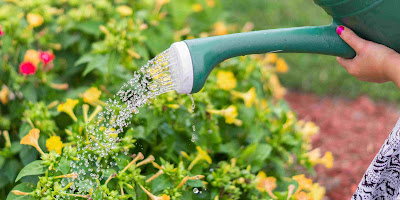 |
In this comprehensive guide, we’ll explore actionable strategies to help your plants thrive with less water, while promoting sustainability and resilience in your outdoor (or indoor) space.
🌱 1. Choose Drought-Tolerant Plants
The easiest way to conserve water is to grow plants that naturally require less of it. Native plants, succulents, and Mediterranean herbs are great examples.
Top drought-tolerant options:
- Lavender
- Sage
- Yarrow
- Echinacea (Coneflower)
- Agave and Aloe Vera
- Ornamental grasses (like Blue Fescue)
Native species are particularly beneficial because they’re adapted to your local climate and soil.
☔️ 2. Improve Soil Health and Structure
Healthy soil retains moisture better. If your soil is sandy or clay-heavy, water will either drain too fast or not at all.
Tips to improve water retention:
- Add compost or organic matter to increase water-holding capacity.
- Use mulch to reduce evaporation and regulate soil temperature.
- Avoid compacting soil; aerate with a garden fork if needed.
Well-structured soil holds water at root level longer, meaning you can water less frequently.
💧 3. Water Deeply, But Infrequently
Frequent, shallow watering leads to weak root systems. The goal is to encourage plants to grow deeper roots that access underground moisture.
Best practices:
- Water early in the morning or late afternoon to reduce evaporation.
- Use a slow drip or soaker hose system.
- Water until the soil is moist 6 inches deep.
Deep watering trains your plants to be more drought-resilient over time.
🚧 4. Use Efficient Irrigation Methods
Automated irrigation systems, when used correctly, can greatly reduce water waste.
Consider:
- Drip irrigation for targeted watering at the root zone
- Soaker hoses for larger beds
- Rain barrels to collect and reuse rainwater
Avoid sprinklers that overshoot or water leaves unnecessarily—this encourages disease and wastes water.
🌾 5. Group Plants by Water Needs
This technique, known as hydrozoning, helps ensure you don’t over- or under-water sections of your garden.
How to hydrozone:
- Group high-water plants (like veggies or ferns) together.
- Keep drought-tolerant plants in a separate zone.
- Tailor your watering schedule to each group’s specific needs.
You’ll use less water overall and reduce the risk of root rot or stress.
🌿 6. Mulch Generously
Mulch is one of the most effective tools for reducing water loss. It prevents evaporation, suppresses weeds, and moderates soil temperature.
Great mulch options:
- Bark or wood chips
- Straw or hay
- Shredded leaves or grass clippings
- Gravel or decorative rocks (for succulents)
Apply a 2-3 inch layer around your plants, but keep mulch a few inches away from stems to prevent rot.
🌞 7. Reduce Lawn Area
Lawns are one of the biggest water guzzlers in a garden. Consider replacing part of your lawn with:
- Native groundcovers
- Flowering meadows
- Gravel or hardscaping
- Edible landscapes (like herb spirals or raised veggie beds)
If you must keep a lawn, choose drought-tolerant grass varieties such as Bermuda, Zoysia, or Buffalo grass.
📆 8. Plant at the Right Time
Timing your planting can reduce the need for supplemental watering. For most climates, early spring or fall is ideal.
Why it matters:
- Cooler temperatures reduce water loss.
- Roots have time to establish before extreme heat.
- Rainfall is typically more consistent in spring/fall.
Avoid planting during the hottest months unless you’re prepared to water frequently.
🌫️ 9. Harvest and Reuse Water
Greywater systems and rain harvesting are great eco-friendly ways to water your garden.
Ideas to get started:
- Install a rain barrel under your gutter downspout.
- Redirect household greywater (like from showers or laundry) to landscape areas (check local regulations first).
- Reuse cooking water (once cooled and unseasoned) to water plants.
These systems reduce strain on municipal water supplies and help build a more sustainable garden.
✨ Final Thoughts
Water-wise gardening isn’t just good for your wallet and the planet—it also creates a resilient, low-maintenance space that can flourish even during dry spells.
By choosing the right plants, improving your soil, using smart watering techniques, and adopting sustainable practices, you can grow a beautiful garden that thrives with less.
Start small, stay consistent, and let your garden lead the way.
Enjoyed this guide? Share it with fellow gardeners and start saving water today!
